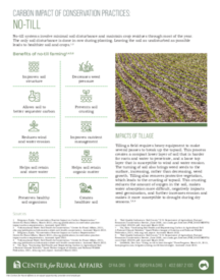No-till systems involve minimal soil disturbance and maintain crop residues through most of the year. The only soil disturbance is done in-row during planting. Leaving the soil as undisturbed as possible leads to healthier soil and crops.
Tilling a field requires heavy equipment to make several passes to break up the topsoil. This process creates a compact lower layer of soil that is harder for roots and water to penetrate, and a loose top layer that is susceptible to wind and water erosion. The turning of soil also brings weed seeds to the surface, increasing, rather than decreasing, weed growth. Tilling also removes protective vegetation, which leads to the crusting of topsoil. This crusting reduces the amount of oxygen in the soil, makes water absorption more difficult, negatively impacts seed germination, and further increases erosion and makes it more susceptible to drought during dry seasons.
See more: Reduced tillage | Extended crop rotation | Cover crops


